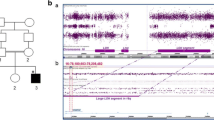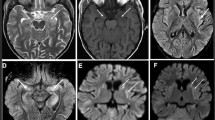Abstract
Progressive encephalopathy, edema, hypsarrhythmia, and optic atrophy (PEHO) syndrome is an unusual Mendelian phenotype of unidentified origin that causes profound intellectual disability, optic nerve/cerebellar atrophy, epileptic seizures, developmental progress, pedal edema, and early death. Uncharacteristic affected individuals are often classified as having PEHO-like syndrome, although they may be misdiagnosed as having epileptic encephalopathy, a potential result of early birth. In this study, we report a consanguineous Saudi family with a novel homozygous nonsense mutation of the CCDC88A gene causing PEHO-like syndrome. The children were suffering from developmental delay, epilepsy, mental disability, optic nerve/cerebellar atrophy, and pedal edema. Whole exome sequencing was conducted for the members of the family who have the disorder to study the novel mutation. Whole exome sequencing data analysis, confirmed by subsequent Sanger sequencing validation, identified a novel homozygous nonsense mutation c. 1292G > A, which was caused by p.Trp431* stop gain. This mutation was ruled out in 100 unrelated healthy controls. The nonsense homozygous mutation detected in this study has not yet been reported as pathogenic in the literature or various databases. In conclusion, a complete loss of protein function due to premature stop gain was caused by a mutation in exon 12 of CCDC88A. This loss may lead to PEHO phenotype. CCDC88A gene may therefore play an important and critical role for multiple aspects of normal human neurodevelopment.


Similar content being viewed by others
References
Anttonen AK, Laari A, Kousi M, Yang YJ, Jääskeläinen T, Somer M, Siintola E, Jakkula E, Muona M, Tegelberg S, Lönnqvist T, Pihko H, Valanne L, Paetau A, Lun MP, Hästbacka J, Kopra O, Joensuu T, Katsanis N, Lehtinen MK, Palvimo JJ, Lehesjoki AE (2017) ZNHIT3 is defective in PEHO syndrome, a severe encephalopathy with cerebellar granule neuron loss. Brain 140(5):1267–1279
Jaen A, Alvarez S, Young E, Ouchi T, Pena M, Duat A, Mayoralas D, Perrone A, Albert J, Calleja-Perez B (2016) Mutations in BRAT1 cause autosomal recessive progressive encephalopathy: report of a Spanish patient. Eur J Paediatr Neurol 20(3):421–425
Shevell M, Colangelo P, Treacy E, Polomeno R, Rosenblatt B (1996) Progressive encephalopathy with edema, hypsarrhythmia, and optic atrophy (PEHO syndrome). J Pediatr Neurosci Elsevier Science 15:337–339
Klein A, Schmitt B, Boltshauser E (2004) Progressive encephalopathy with edema, hypsarrhythmia and optic atrophy (PEHO) syndrome in a Swiss child. Eur J Paediatr Neurol 8:317–321
Cross J, Guerrini R (2013) The epileptic encephalopathies. Handbook Clin Neurol 111:619–626
Nahorski M, Asai M, Wakeling E, Parker A, Asai N, Canham N, Holder S, Chen Y, Dyer J, Brady A, Takahashi M, Woods G (2016) CCDC88A mutations cause PEHO-like syndrome in humans and mouse. BRAIN 139:1036–1044
Chitty L, Robb S, Berry C, Silver D, Baraitser M (1996) PEHO or PEHO-like syndrome? Clin Dysmorphol 5:143–152
Salonen R, Somer M, Haltia M, Lorentz M, Norio R (1991) Progressive encephalopathy with edema, hypsarrhythmia, and optic atrophy (PEHO syndrome). Clin Genet 39:287–293
Somer M, Sainio K (1993) Epilepsy and the electroencephalogram in progressive encephalopathy with edema, hypsarrhythmia, and optic atrophy (the PEHO syndrome). Epilepsia 34(4):727–731
Fujimoto S, Yokochi K, Nakano M, Wada Y (1995) Progressive encephalopathy with edema, hypsarrhythmia, and optic atrophy (PEHO syndrome) in two Japanese siblings. Neuropediatrics 26:270–272
Tanouchi A, Taniuchi K, Furihata M, Naganuma S, Dabanaka K, Kimura M, Watanabe R, Kohsaki T, Shimizu T, Saito M, Hanazaki K, Saibara T (2016) CCDC88A, a prognostic factor for human pancreatic cancers, promotes the motility and invasiveness of pancreatic cancer cells. J Exp Clin Cancer Res 35:190
Longman C, Tolmie J, McWilliam R, MacLennan A (2003) Cranial magnetic resonance imaging mistakenly suggests prenatal ischemia in PEHO-like syndrome. Clin Dysmorphol 12:133–136
Field M, Grattan P, Piper S, Thompson E, Haan E, Edwards M, James S, Wilkinson I, Ade’s L (2003) PEHO and PEHO-like syndromes: report of five Australian cases. Am J Med Genet A 122A:6–12
Acknowledgments
The authors also, acknowledge with thanks Science and Technology Unit, King Abdul-Aziz University for technical support.
Funding
This project was funded by the National Plan for Science, Technology and Innovation (MAARIFAH)—King Abdul-Aziz City for Science and Technology—the Kingdom of Saudi Arabia—award number (12-BIO3059-03).
Author information
Authors and Affiliations
Contributions
M. I. N. conceived and designed the project. M. I. N. and A. A. A. performed experiments and confirmed these results. M. I. N., M. A. J., and A. G. C. analyzed and interpreted the data. M. I. N. and M. A. J. provided and interpreted phenotypic details for the patients. M. H. A., A. G. C., and K. O. A. advised on the study design and writing of the manuscript. M. I. N wrote the manuscript.
Corresponding author
Ethics declarations
Conflict of interest
The authors declare that they have no conflict of interest.
Rights and permissions
About this article
Cite this article
Abdulkareem, A.A., Abulnaja, K.O., Jan, M.M. et al. A novel homozygous nonsense mutation in CCDC88A gene cause PEHO-like syndrome in consanguineous Saudi family. Neurol Sci 40, 299–303 (2019). https://doi.org/10.1007/s10072-018-3626-5
Received:
Accepted:
Published:
Issue Date:
DOI: https://doi.org/10.1007/s10072-018-3626-5




